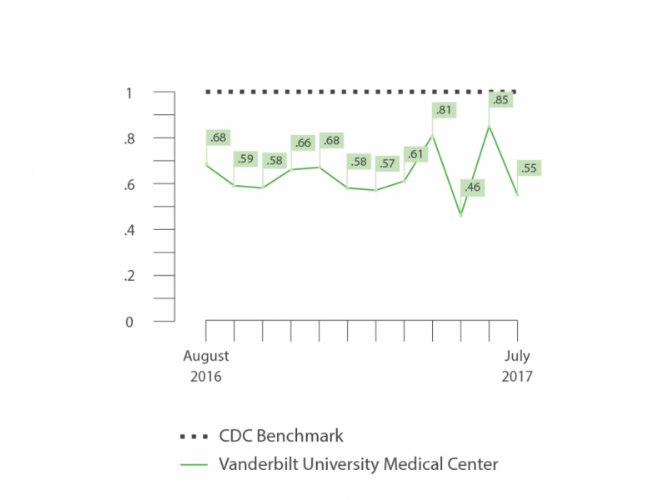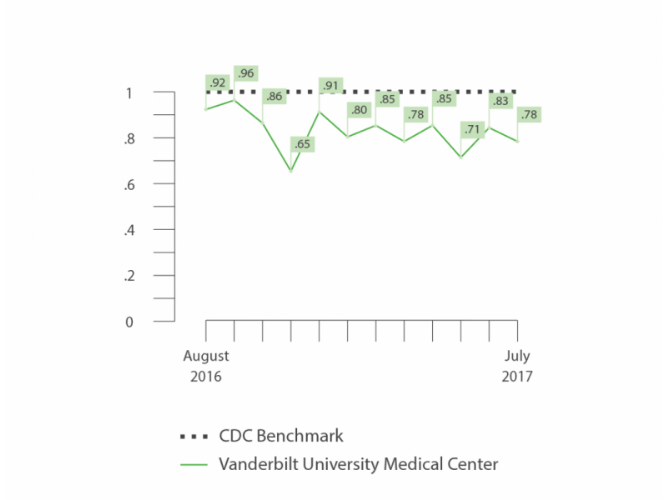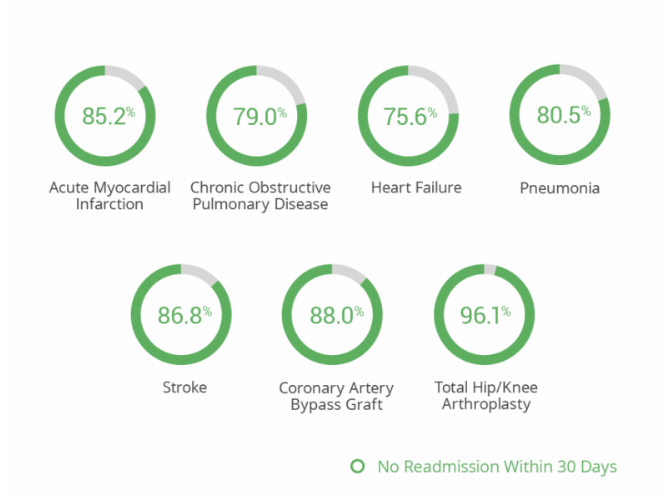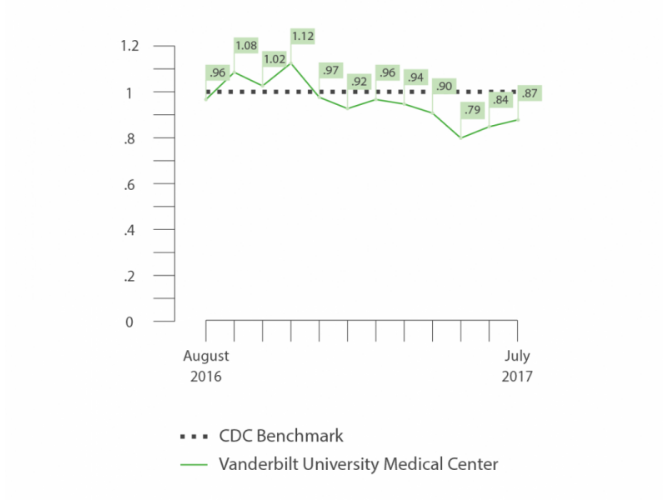Quality Reports
Protecting patients from infections
At Vanderbilt, our patients' safety comes first. We go to great lengths to make our facilities clean and safe, and our faculty and staff follow proven practices for infection control. We have one of the nation's most rigorous hand hygiene programs in place, and we strive every day to get better.
The graph below shows the rate of healthcare-associated infection at Vanderbilt University Medical Center from August 2016 to July 2017. Compared to the national average, we are successful at protecting our patients from infection.
However, our goal is perfection.
Source: Centers for Disease Control and Prevention/National Healthcare Safety Network

Reducing adverse events
We believe patient safety is paramount, and our record shows it.
An adverse event is anything that injures a patient as the result of a medical treatment, as opposed to the patient's medical condition. This category includes patient falls, bed sores and other events.
This graph shows how Vanderbilt University Medical Center beats the national average in this metric.
Source: Vizient

Reducing readmissions
In many cases, if we do our job well, our patients won't need to come back to the hospital. This is true for patients who have several conditions, including:
- Acute myocardial infarction (heart attack)
- Chronic obstructive pulmonary disease (COPD)
- Heart failure
- Pneumonia
- Stroke
- Coronary artery bypass graft
- Total hip arthroplasty (replacement) / total knee arthroplasty (replacement)
This measure shows how many of our patients with these conditions are re-admitted to the hospital after they are released. It shows that we are successful in helping our patients get back to living healthy lives.
We do this a number of ways, including:
- Following proven methods of care
- Educating our patients about their medicines and post-care routines
Source: CMS Inpatient Quality Reporting

Guarding patients' lives
This graph shows how well we care for very complex cases and help our patients live to recover from their conditions. Observed to Expected Mortality is the figure that measures this ability.
Vanderbilt University Medical Center often beats the national average. A number below 1.0 means that fewer patients die in the hospital than would be expected. Given how many serious and complicated cases Vanderbilt treats, our patients often survive at a better-than-expected rate.
Source: Vizient

How we're getting better
We're proud of our safety and quality record, but we're always pursuing ways to improve. Here is a small sample of programs in which we've started to get even better at the things that matter most to you and your loved ones.
Clean hands save lives
We have one of the strongest, most stringent hand-washing programs in the country. If this sounds simple, it is. But research shows that if providers have clean hands every time they see a patient, the result is fewer infections, which means fewer complications and deaths.
We don't just ask doctors, nurses and other providers whether they've washed their hands. We've placed anonymous monitors throughout the medical center to report on what they see, so our data comes from the real world. We also have a number of programs in place to remind and encourage our providers to wash their hands at certain times to help protect patients. This method is the gold standard recommended by the World Health Organization (WHO) and Center for Disease Control (CDC).
Reducing adverse events
We have special teams in place to help prevent pressure ulcers in 21 Vanderbilt University Hospital units. We've phased in more safety products and targeted high-risk ares, and the result has been a major decrease in patients with hospital acquired pressure ulcers.
Fall prevention
Our fall prevention teams include experts from a wide range of fields, including physical therapy, pharmacology and nursing. Our goal is to establish special fall prevention rounds that focus on reducing patient falls throughout the medical center.
Enhanced safety measures
Based on the guidelines of the Joint Commission on the Accreditation of Healthcare Organizations, we follow programs and practices that reduce treatment errors and infection:
Computerized medical record system: Gives providers at-the-bedside electronic access to information about a patient's condition, medications and treatment plan. Cuts down on time needed to find medical records and streamlines the use of medical information, so your provider can diagnose and treat you quicker and more efficiently.
Bar-coded medication verification system: Reduces errors in medication type and dosage. This feature also cuts down on harmful drug interactions.
Information campaign: We educate patients and their families about routine safety checks related to tests, medications and surgeries.
More quality reports
We've been patients, too. Like you, we want to know the truth about our doctors, our nurses and our treatments. There are a number of websites you can visit to find out more about Vanderbilt. We report data to:
Centers for Medicare and Medicaid Services (CMS), a service of the U.S. Department of Health and Human Services tasked with strengthening and modernizing healthcare systems, while providing quality care at lower costs.
Magnet Recognition Program, developed by the American Nurses Credentialing Center (ANCC), recognizes healthcare organizations for quality patient care, nursing excellence and innovations in professional nursing practice. Magnet designation is the ultimate credential for high quality nursing.
The Joint Commission, accredits and certifies healthcare organizations and programs in the U.S. Joint Commission accreditation, and certification is recognized across the country as a symbol of quality that reflects an organization’s commitment to meeting certain performance standards.
The Leapfrog Group. Leapfrog gathers and reports information on hospital quality and patient safety efforts to help patients make informed decisions about where to receive hospital care. The Leapfrog Group is well-known for its Hospital Quality and Safety Survey. As part of this, Leapfrog scores hospitals based on their adherence to 27 healthcare practices. This score is known as a Safe Practices Score.